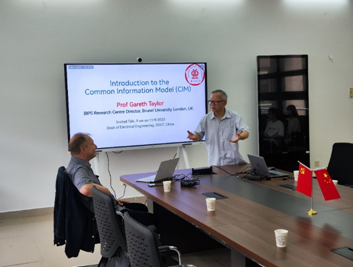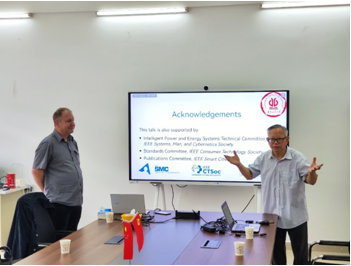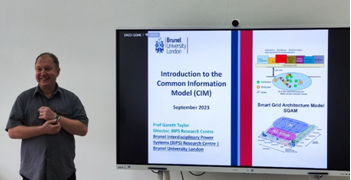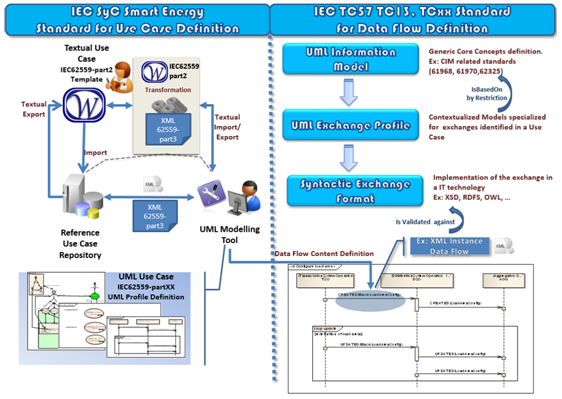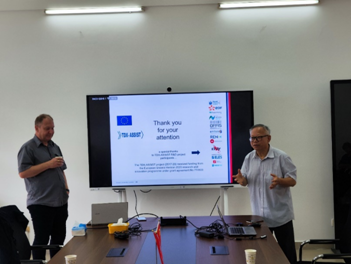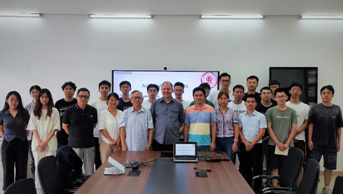Introduction to the Common Information Model (CIM) and Standardisation
Written by Yu Wang, Junhua Wu, and Zhanlian Li
On Monday, 11 September 2023, Professor Gareth Taylor of Brunel University, London delivered an invited lecture at Guangdong University of Technology (GDUT)’s University Town campus in Guangzhou China. This event was chaired by Professor Loi Lei Lai, a University Distinguished Professor and an IEEE Life Fellow from the School of Automation. Figure 1 shows Professor Lai’s introduction of Professor Taylor.
Figure 1: Talk Introduction.
Figure 2: Sponsored units.
Figure 2 shows some of the sponsored units for the lecture event.
The event was supported by:
- Intelligent Power and Energy Systems Technical Committee, IEEE Systems, Man, and Cybernetics Society;
- Standards Committee, IEEE Consumer Technology Society; and
- Publications Committee, IEEE Smart Cities.
In the opening remarks, Professor Loi Lei Lai warmly welcomed Professor Gareth Taylor and provided a brief introduction to his impressive work experience in standards development and his leadership in power systems research. Professor Gareth Taylor currently serves as the Director of the Brunel Interdisciplinary Power Systems (BIPS) Research Centre and as an expert member of the UK Working Group on the Planned UK Regulatory Adoption of CIM, as led by the UK Regulator OFGEM. Professor Loi Lei also acknowledged the collaborators and supporting units involved in organizing this talk.
Figure 2: Professor Taylor gave his invited presentation.
As shown in Figure 3, during the presentation, Professor Gareth Taylor delved into the topic of the Common Information Model (CIM), focusing specifically on its application in the context of transmission and distribution system interoperability. He structured his discussion around four key aspects of CIM, namely: overview, fundamentals, adoption, and benefits.
To begin, Professor Gareth Taylor offered an overview of CIM, providing insights into its origin and development. He explained that CIM initially originated as the Control Center API (CCAPI) project, which was spearheaded by the Electric Power Research Institute (EPRI) in the United States. The overarching aim of the project was to enhance the control centre operations in the electric power sector. Building upon this foundation, CIM was subsequently adopted and standardized by the International Electrotechnical Commission (IEC) TC57 Working Group 13 as IEC 61970-301. This standard defines a comprehensive series of packages and classes represented in Unified Modeling Language (UML), with a specific focus on software interfaces for the operation and planning of the electric grid. Notably, CIM has evolved to encompass a wide range of related IEC standards, reflecting the collaborative efforts of multiple TC57 Working Groups.
Professor Gareth Taylor proceeded to discuss the fundamental principles underlying CIM. He highlighted the role of CIM in facilitating effective communication and data exchange within the electric power industry. By adopting a standardized approach to modeling and information representation, CIM enables interoperability between different systems, devices, and applications. This standardization is crucial for streamlining operations, optimizing planning processes, and promoting efficient decision-making across the electric grid.
In terms of adoption, Professor Gareth Taylor shed light on the widespread acceptance and implementation of CIM in the industry. He emphasized that CIM has gained significant traction, particularly due to its endorsement and support from key industry stakeholders. Notably, CIM was officially adopted and standardized by the IEC as IEC 61970-301, marking a crucial milestone in its recognition and utilization within the global energy sector.
To further illustrate the practical applications of CIM, Professor Gareth Taylor presented specific use cases and examples. One such example was the TSO-DSO Business and System Use Case, which showcases how CIM can be effectively applied and developed as the Common Grid Model Exchange Standard (CGMES) to enable enhanced coordination between Transmission System Operators (TSOs) and Distribution System Operators (DSOs). By leveraging CIM and CGMES, TSOs, and DSOs, this can efficiently procure distributed flexibility resources while avoiding any duplication or counter activation of the same resources. This streamlined coordination mechanism not only optimizes resource allocation, but also mitigates potential challenges and conflicts that may arise from inefficient or redundant activations.
Additionally, Professor Gareth Taylor introduced CGMES and related extension methods. CGMES serves as a standardized format for the exchange of information, specifically focused on Business Objects within the context of TSO-DSO Use Cases. By adopting, developing, and extending CGMES, stakeholders can effectively express and interpret relevant information, thereby ensuring accurate and seamless data exchange between TSOs, DSOs, and other market operators or participants.
Figure 4: CIM Adoption Methodology: Use Cases and Profiles
Figure 5: Discussions on global standards development.
In the context of CIM profiles, Professor Gareth Taylor emphasized their importance and implications. Specifically, he discussed recent CIM profile developments based on European Style Market Profiles (ESMP). The purpose of these profiles is twofold: first, they serve as a validation mechanism for the coordination between TSOs and DSOs in procuring distributed flexibility resources. This validation ensures that there is no double activation or counter activation of the same flexibility resource by both entities, thereby optimizing resource utilization. Second, CIM profiles play a crucial role in preventing negative impacts associated with offer activations within networks. By defining the necessary data exchanges between TSOs, DSOs, and market operators, CIM profiles facilitate efficient and effective communication, fostering seamless collaboration within the energy market.
Professor Gareth Taylor also highlighted several interoperability challenges that arise when applying CIM to various applications and processes. One prominent challenge is the overlap between different standards, which can lead to unnecessary duplication and inconsistencies. Addressing this issue requires collaborative efforts from industry stakeholders to streamline and align these standards effectively. Additionally, there are concerns regarding information and data ownership, as well as security. It is essential to establish clear guidelines and frameworks to address these concerns and ensure secure and reliable data exchange and utilization. Figure 4 illustrates significant achievements in standards development and presents a CIM adoption methodology.
When summarizing the benefits of CIM, Professor Gareth Taylor emphasized the rapidly evolving nature of information and data requirements across the energy sector. With the effective utilization of information and data, valuable insights can be derived for consumers, system operators, and energy market participants. The standardized representation of data through CIM enables stakeholders to make informed decisions, optimize operations, and develop innovative solutions.
Throughout the presentation, Professor Taylor and Professor Lai engaged in on-site interactions and discussions, exploring potential synergies between IEEE and IEC standards. Recognizing the importance of collaboration and knowledge exchange, they expressed a shared desire to strengthen communication and cooperation between Brunel University and GDUT. Such collaborations have immense potential to drive further advancements in the field of energy systems and contribute to the overall growth and development of the industry. Figure 6 shows some of the delegates in attending the talk.
Figure 6: Professor Taylor with some of the attending delegates.
In conclusion, the presentation delivered by Professor Gareth Taylor at GDUT, as shown in Figures 5 and 6, proved to be an enlightening and thought-provoking event. By shedding light on the Common Information Model (CIM) and its various aspects, Professor Taylor provided valuable insights into the significance and practical applications as well as the developments of CIM within the energy sector. The discussion around CIM's overview, fundamentals, adoption, and benefits demonstrated its critical role in enabling effective data communication and information exchange, optimizing operations at whole system levels, and supporting informed decision-making. Moreover, the interactive session from all showcased the potential for collaboration and knowledge sharing between international institutions. Overall, this presentation served as a catalyst for further exploration and advancement in the field of data-driven smart energy systems.
This article was edited by Loi Lei Lai.
To view all articles in this issue, please go to November 2023 eNewsletter. For a downloadable copy, please visit the IEEE Smart Cities Resource Center.
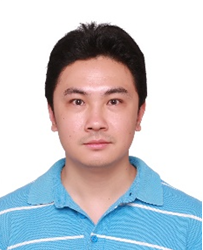

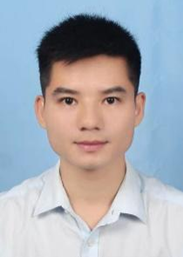
To have the eNewsletter delivered monthly to your inbox, join the IEEE Smart Cities Community.
Past Issues
To view archived articles, and issues, which deliver rich insight into the forces shaping the future of the smart cities. Older eNewsletter can be found here. To download full issues, visit the publications section of the IEEE Smart Cities Resource Center.


